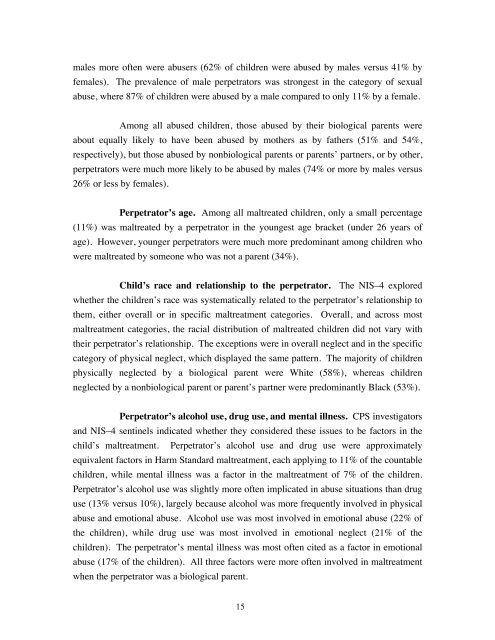National Incidence Study of Child Abuse and ... - Children's Central
National Incidence Study of Child Abuse and ... - Children's Central
National Incidence Study of Child Abuse and ... - Children's Central
- No tags were found...
You also want an ePaper? Increase the reach of your titles
YUMPU automatically turns print PDFs into web optimized ePapers that Google loves.
males more <strong>of</strong>ten were abusers (62% <strong>of</strong> children were abused by males versus 41% byfemales). The prevalence <strong>of</strong> male perpetrators was strongest in the category <strong>of</strong> sexualabuse, where 87% <strong>of</strong> children were abused by a male compared to only 11% by a female.Among all abused children, those abused by their biological parents wereabout equally likely to have been abused by mothers as by fathers (51% <strong>and</strong> 54%,respectively), but those abused by nonbiological parents or parents’ partners, or by other,perpetrators were much more likely to be abused by males (74% or more by males versus26% or less by females).Perpetrator’s age. Among all maltreated children, only a small percentage(11%) was maltreated by a perpetrator in the youngest age bracket (under 26 years <strong>of</strong>age). However, younger perpetrators were much more predominant among children whowere maltreated by someone who was not a parent (34%).<strong>Child</strong>’s race <strong>and</strong> relationship to the perpetrator. The NIS–4 exploredwhether the children’s race was systematically related to the perpetrator’s relationship tothem, either overall or in specific maltreatment categories. Overall, <strong>and</strong> across mostmaltreatment categories, the racial distribution <strong>of</strong> maltreated children did not vary withtheir perpetrator’s relationship. The exceptions were in overall neglect <strong>and</strong> in the specificcategory <strong>of</strong> physical neglect, which displayed the same pattern. The majority <strong>of</strong> childrenphysically neglected by a biological parent were White (58%), whereas childrenneglected by a nonbiological parent or parent’s partner were predominantly Black (53%).Perpetrator’s alcohol use, drug use, <strong>and</strong> mental illness. CPS investigators<strong>and</strong> NIS–4 sentinels indicated whether they considered these issues to be factors in thechild’s maltreatment. Perpetrator’s alcohol use <strong>and</strong> drug use were approximatelyequivalent factors in Harm St<strong>and</strong>ard maltreatment, each applying to 11% <strong>of</strong> the countablechildren, while mental illness was a factor in the maltreatment <strong>of</strong> 7% <strong>of</strong> the children.Perpetrator’s alcohol use was slightly more <strong>of</strong>ten implicated in abuse situations than druguse (13% versus 10%), largely because alcohol was more frequently involved in physicalabuse <strong>and</strong> emotional abuse. Alcohol use was most involved in emotional abuse (22% <strong>of</strong>the children), while drug use was most involved in emotional neglect (21% <strong>of</strong> thechildren). The perpetrator’s mental illness was most <strong>of</strong>ten cited as a factor in emotionalabuse (17% <strong>of</strong> the children). All three factors were more <strong>of</strong>ten involved in maltreatmentwhen the perpetrator was a biological parent.15
















